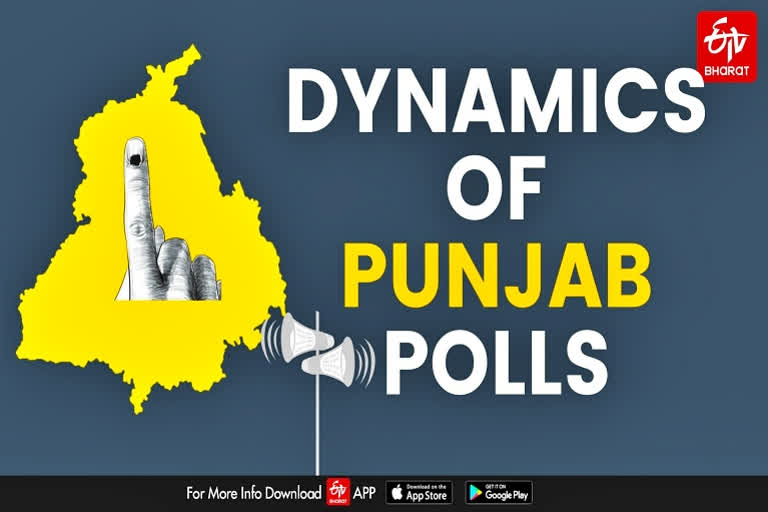In the last lap of the campaign for the 117 member Punjab Assembly, there has been a flurry of activity on the part of the top leadership of the BJP. Prime Minister Narendra Modi last week held an exclusive chat with Baba Gurinder Singh Dhillion, chief of the Radha Soami Satsang, Beas. On Wednesday, Home Minister Amit Shah travelled to Beas for a meeting with the same Baba.
On Sunday, the Home Minister was in Amritsar for a meeting with Gyani Harpreet Singh, and chief Jathedar of the Akal Takht. Not unrelated, too, is this development: The recent release on furlough of the incarcerated chief of the Dera Sacha Sauda, Baba Gurmeet Ram Rahim - whose supporters had been accused in the 2015 Gurudwara sacrilege case. So, the apparent question: What explains the dalliance of the BJP leadership with the "Babas" of Punjab?
AAP as the frontrunner
Survey reports indicate that Arvind Kejriwal's Aam Aadmi Party (AAP) will emerge the biggest party in the February 20 elections, with the Congress being placed a close second. The BJP - which is contesting 64 seats in alliance with Captain Amarendra Singh's Punjab Lok Congress (30 seats) and 17 seats of Sukhbir Singh Dhindsa's Shiromani Akali Dal (United) - is not seen as a major political force in the state. Sukhbir Singh Badal's Shiromani Akali Dal (SAD) has also been on the backfoot for dual reasons: The party's perceived anti-Sikh positioning in the 2015 sacrilege cases when pages of the Guru Granth Sahib were found desecrated - as also because party leaders were seen as being opposed to the year-long farmers protests outside Capital New Delhi's borders.
By all accounts, the Punjab campaign - which ended Friday - had come to centre around the AAP. In a recently released video, former AAP leader Kumar Vishwas has accused Kejriwal of "having plotted to become the Prime Minister of an independent country of Khalistan in the previous 2017 elections". At a recent rally in Punjab, Prime Minister Narendra Modi hit out against "those who were hand in glove with the anti national elements".
Congress leader Rahul Gandhi has demanded that Kejriwal must clarify whether he was for or against the Khalistanis, while Punjab Chief Minister Charanjit Singh Channi has threatened to launch sedition charges against his Delhi counterpart. The point is this: The AAP has emerged the fulcrum around which this Punjab elections have come to revolve.
The AAP dilemmas
After witnessing ten years of SAD government followed by a five year rule of the Congress, the Punjab electorate is apparently inclined or willing this time to experiment with the AAP. But there are fault lines and past burdens that are continuing to plague the party's prospects. In the previous 2017 elections, for instance, the AAP had emerged the preferred choice of voters, until it's popularity plummeted rapidly after Kejriwal's visit at the residence of a known Khalistani terrorist.
Before the incident happened, the AAP had put up posters declaring that it would win 80 seats and form the government. The party ended up with 20 wins, with 11 of their legislators switching sides in the intervening years. In the 2019 parliamentary elections, the AAP vote share in the state shrunk to single digit figures. So, despite the popular support this time, will the AAP be able to convert the favourable circumstances into votes, so as to provide for a stable, lasting and credible government in the state? This is a million dollar question.
Hung Assembly prospects
The BJP - always a doughty political fighter - seems determined and willing to fight out the Punjab battle to the finish - despite the party's current unfavourable circumstances. If the AAP's lead gets reduced and the Congress remains short of the majority mark of 59 members in the state assembly, the BJP can be expected to engage in post-poll management. The six "deras" of Punjab are said to have an influence in 68 assembly seats, with the more prominent Dera Sacha Souda and the Radha Soami Satsang estimated to have an influence over 27 and 19 seats respectively.
Second rung BJP leaders are also said to have established contact in recent days with the chiefs of other "deras" including the Noormahal Dera (Divya Jyoti Jagran Sansthan), Dera Sachkhand Ballan and the Sant Nirankari Mission. The BJP's calculation is that, with the support of the Deras, the party could win approximately 25 seats. Sukhbir Badal's Shiromani Akali Dal (SAD) is also expected to improve its position since 2017, when the party had won only 17 seats.
In such a scenario, the BJP could try to rustle up a majority with the support of Sukhbir Badal's SAD, Captain Amarendra Singh's Rashtriya Lok Congress, Sukhbir Singh Dhindsa's SAD (United) plus Independents. A post-poll alliance between the BJP and the SAD is not being ruled out, with some of the "dera" Chiefs likely to play a role in bringing about a rapprochement between the former alliance partners. In other words, the BJP seems working on a hung assembly prospects.
Also read: How Deras influence Punjab politics and why are parties making a beeline to them?
(Disclaimer: The opinions expressed in this article are that of the writer. The facts and opinions expressed here do not reflect the views of ETV Bharat.)


